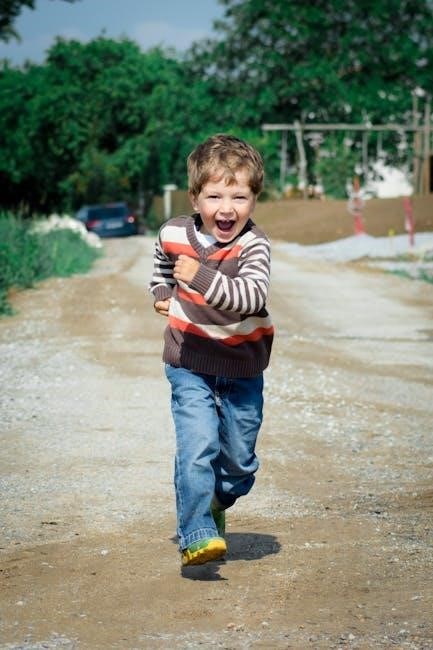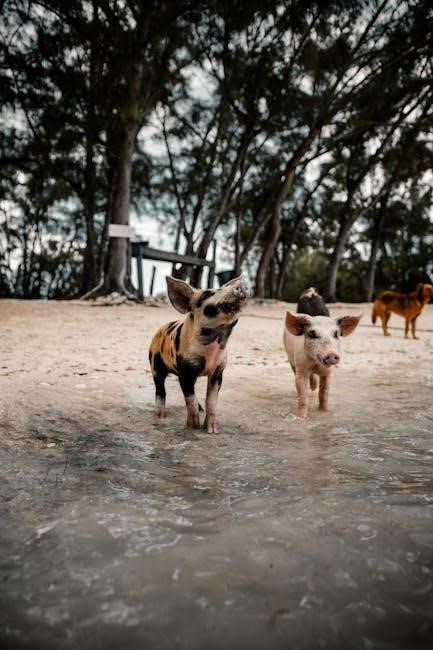
Story Summary
The three little pigs, Higgle, Niggle, and Walter, build houses of straw, sticks, and bricks to outwit the Big Bad Wolf, who relentlessly tries to blow them down.
1;1. Plot Overview
The story of the Three Little Pigs revolves around three pig brothers—Higgle, Niggle, and Walter—who set out to build their own houses. The first two pigs, Higgle and Niggle, hastily construct their homes using straw and sticks, prioritizing speed over strength. In contrast, Walter, the wisest brother, takes his time to build a sturdy brick house. Meanwhile, the Big Bad Wolf, with his powerful lungs, seeks to blow down their houses to eat them. The wolf easily destroys the straw and stick houses, forcing the first two pigs to flee to Walter’s brick house. The wolf attempts to blow it down but fails, leading to a climactic chase and the ultimate defeat of the wolf. This tale of preparation, laziness, and survival forms the core of the story;
1.2. Main Characters
The story features three main characters: the Three Little Pigs (Higgle, Niggle, and Walter) and the Big Bad Wolf. Higgle and Niggle are impulsive and lazy, building houses of straw and sticks, respectively, which are easily destroyed. Walter, the wisest and most hardworking brother, constructs a sturdy brick house, showcasing his foresight and preparation. The Big Bad Wolf, with his powerful lungs and cunning nature, serves as the antagonist, seeking to devour the pigs. His relentless efforts to blow down their houses drive the story’s conflict. These characters embody the themes of hard work, laziness, and survival, making them central to the narrative’s moral and dramatic structure. Their distinct personalities and actions shape the story’s outcome, highlighting the importance of wisdom and preparation.
1.3. Climax and Resolution
The climax occurs when the Big Bad Wolf, after failing to blow down the brick house, attempts to enter through the chimney. The pigs, anticipating this, prepare a pot of boiling water, which scalds the wolf, leading to his retreat. In the resolution, the three little pigs celebrate their victory, safe inside the sturdy brick house. Walter’s wisdom and preparation ensure their survival, while the wolf’s defeat serves as a consequence of his malicious intentions. This ending reinforces the moral lessons of hard work and foresight, as the pigs live happily and securely in their strong home. The story concludes with a clear triumph of good over evil, leaving a lasting impression on readers.

Moral Lessons
The story emphasizes the importance of preparation and hard work, contrasting the consequences of laziness. It teaches that wisdom and foresight lead to safety and success, while recklessness invites trouble.
2.1. Importance of Preparation
The story of the Three Little Pigs underscores the importance of preparation and its role in ensuring safety and success. The first two pigs, who hastily built their houses with straw and sticks, were unprepared for the Big Bad Wolf’s attacks. Their lack of effort and foresight led to their homes being easily destroyed. In contrast, the third pig, who meticulously built his house with bricks, demonstrated the value of preparation. His hard work and planning allowed him to withstand the wolf’s relentless efforts. This moral lesson highlights how preparation and diligence can help individuals overcome challenges and avoid unnecessary risks, making it a timeless teaching tool for children and adults alike.
2.2. Consequences of Laziness
The tale of the Three Little Pigs vividly illustrates the consequences of laziness. The first two pigs, driven by laziness, quickly constructed their houses using straw and sticks, prioritizing speed over strength. Their lack of effort made their homes vulnerable to the Big Bad Wolf’s attacks, resulting in destruction and chaos. The pigs’ laziness not only endangered their lives but also forced them to rely on their brother for safety. This moral lesson emphasizes how neglecting to put in effort can lead to dire outcomes, teaching the importance of responsibility and diligence. The story serves as a cautionary tale about the repercussions of taking shortcuts and ignoring the need for thorough preparation.
2.3. Value of Wisdom
The story of the Three Little Pigs highlights the value of wisdom through the actions of the third pig. Unlike his brothers, he demonstrated foresight and wisdom by building a strong brick house, anticipating the Big Bad Wolf’s threats. His wisdom not only saved his own life but also provided a safe refuge for his less prepared siblings. The tale underscores how wisdom leads to better decision-making and preparation, ultimately ensuring safety and success. The third pig’s prudent choices serve as a timeless lesson in the importance of thinking ahead and using intelligence to overcome challenges. This moral teaches children and adults alike the rewards of being wise and prepared in the face of adversity.
Digital versions of The Three Little Pigs are widely available in formats like PDF, offering interactive features such as animations and clickable elements for enhanced engagement. The PDF version of The Three Little Pigs is a popular choice for its portability and readability across devices. This format preserves the story’s illustrations and text layout, making it ideal for digital devices. Many websites offer free downloads of the story in PDF, catering to both children and educators. The PDF version often includes colorful visuals and engaging typography, enhancing the storytelling experience. It is also easily shareable and can be accessed offline, making it a convenient option for classrooms or home use. Additionally, some PDF versions include interactive elements like clickable links or animations, adding an extra layer of engagement for young readers. Overall, the PDF format ensures the timeless tale remains accessible and enjoyable in the digital age. The PDF version of The Three Little Pigs can be easily downloaded from various online platforms, including educational websites, digital libraries, and e-bookstores. Many sites offer free downloads, making it accessible to a wide audience. Users can search for “3 little pigs pdf” to find direct links or visit trusted sources like Google Drive or Dropbox, where the story is often shared. Some platforms may require registration, while others provide instant access. Additionally, paid versions with enhanced illustrations or interactive features are available for purchase. Downloading the PDF allows readers to enjoy the story offline on devices like tablets, smartphones, or computers. This convenience makes it a popular choice for both personal and educational use. Many 3 Little Pigs PDF versions include interactive features that enhance the storytelling experience. These may include clickable animations, voice narration, and puzzles. Some editions allow readers to engage with characters by clicking on them to trigger actions or sounds. Quizzes and games embedded within the PDF teach moral lessons and test comprehension. Certain versions offer a “Build Your House” activity, where children can digitally assemble houses using straw, sticks, or bricks. These features make the story more immersive and educational, appealing to both children and educators. They also encourage active participation, making learning fun and engaging. Interactive elements are particularly useful for classroom settings, helping students retain the story’s lessons. The 3 Little Pigs PDF serves as an excellent educational resource, promoting literacy, moral lessons, and critical thinking. It’s widely used in classrooms for engaging storytime and educational activities. The 3 Little Pigs PDF is a versatile teaching tool that educators use to convey moral lessons and promote interactive learning. Its engaging storyline helps students understand the importance of preparation and hard work. Teachers incorporate the story into lesson plans to discuss themes like good vs. evil and deception. The PDF format allows for easy distribution and display in classrooms, making it accessible for group readings and discussions. Additionally, the story’s relatable characters and clear plot make it an effective resource for teaching language skills and critical thinking. Its simplicity ensures it is suitable for various age groups, enhancing its versatility as a teaching aid. The 3 Little Pigs PDF is widely used as a resource for language learning due to its simple and repetitive structure, making it ideal for learners of all levels. The story’s clear narrative and moral lessons help students grasp basic vocabulary and sentence structures. Educators often use the tale to teach sequencing, cause-and-effect relationships, and comprehension skills. The PDF format allows for easy accessibility, enabling learners to highlight and revisit key phrases. Additionally, the story’s cultural significance provides a window into traditional storytelling, enriching language acquisition with cultural context. Its engaging nature ensures that learners stay motivated while improving their language proficiency. This makes the 3 Little Pigs a valuable tool for language education worldwide. The 3 Little Pigs PDF offers a variety of engaging classroom activities that enhance learning. Teachers can use the story to create interactive lessons, such as sequencing events, where students arrange the plot in order. Group discussions can focus on the moral lessons, encouraging critical thinking and collaboration. Art projects, like drawing the pigs’ houses, foster creativity while reinforcing the story’s themes. Role-playing activities allow students to act out scenes, improving communication skills. Additionally, the PDF can be used for comprehension exercises, quizzes, and writing prompts, such as imagining alternative endings. These activities make learning fun and interactive, catering to diverse learning styles and promoting student engagement. The story’s simplicity and depth provide endless opportunities for creative and educational exercises. The 3 Little Pigs has become a beloved tale worldwide, inspiring numerous adaptations in films, plays, and educational materials. Its moral lessons resonate across cultures, making it timeless. The story of the 3 Little Pigs has been adapted into various forms, including films, stage plays, and educational materials. Its timeless appeal has led to numerous creative interpretations. Many adaptations maintain the core moral lessons while adding unique twists to engage modern audiences. For instance, some versions incorporate music, while others use animation to bring the characters to life. The tale has also been translated into multiple languages, further broadening its reach. Additionally, educational PDFs and children’s apps have been developed to teach the story interactively. These adaptations ensure the story remains relevant and accessible to new generations, preserving its cultural significance. The 3 Little Pigs story holds significant cultural value as a timeless fable that transcends age and geography. It has been a cornerstone of children’s literature, teaching essential life lessons. The tale’s themes of preparation, hard work, and cleverness resonate universally, making it a beloved story across cultures. Its inclusion in educational materials, such as PDFs, highlights its importance in teaching moral values. The story’s characters and plot have become part of popular culture, with references in films, music, and art. This widespread recognition underscores its enduring impact on society, solidifying its place as a cultural icon. The story continues to inspire new adaptations, ensuring its relevance in modern times. The 3 Little Pigs story has been reimagined in various modern formats, such as interactive PDFs and digital adaptations. These versions often incorporate fresh twists, like environmental lessons or diversity themes, appealing to contemporary audiences. The story is frequently used in classrooms to teach critical thinking and moral values. Its timeless themes of hard work and cleverness continue to resonate, making it a popular choice for educational purposes. Modern interpretations also explore the wolf’s backstory, adding depth to his character. The story’s adaptability ensures its relevance in today’s fast-evolving world, making it a cherished tale for new generations. Its enduring appeal lies in its ability to evolve while retaining its original charm. The three little pigs represent different traits: laziness, impulsiveness, and wisdom. The Big Bad Wolf symbolizes cunning and greed, while the pigs’ actions highlight preparedness and foresight. The Big Bad Wolf is the antagonist, known for his cunning and relentless pursuit of the three little pigs. His physical strength and intimidating presence make him a formidable character. The wolf’s determination to blow down the pigs’ houses highlights his greed and impatience. His actions drive the story’s conflict and serve as a catalyst for the pigs’ survival strategies. Despite his epic lungs and clever tricks, the wolf ultimately fails, teaching a lesson about the consequences of greed and laziness. His character emphasizes the importance of preparation and wisdom, as seen in the pigs’ varying levels of success. The wolf’s role is crucial in showcasing the moral lessons of the story, making him a memorable and symbolic figure. The three little pigs, named Higgle, Niggle, and Walter, are the protagonists of the story. Each pig represents different traits: Higgle and Niggle are hasty and lazy, while Walter is wise and hardworking. Their decisions to build houses of straw, sticks, and bricks, respectively, showcase their personalities and preparedness. Higgle and Niggle’s quick, careless construction lead to their downfall, while Walter’s patience and effort save him from the Big Bad Wolf. The pigs’ experiences highlight the importance of hard work and planning. Their story serves as a moral lesson, contrasting the consequences of laziness with the rewards of wisdom and preparation. The pigs’ actions and outcomes make them central to the story’s theme of survival and growth. The story of the three little pigs is enriched by various supporting characters, such as Old Macdonald, who brings the pigs to life with his storytelling and props like stuffed animals or masks. These characters add depth to the narrative, showcasing the pigs’ interactions within a broader community. For instance, the pigs may use props like straw, sticks, and bricks to demonstrate their building skills, while other farm animals like chickens and ducks provide a lively backdrop. These supporting elements highlight the pigs’ resourcefulness and creativity, emphasizing themes of teamwork and community support. The presence of these characters also makes the story more engaging, especially for younger audiences, by creating a relatable and dynamic environment. The story explores themes like hard work, preparation, and consequences, with the pigs’ houses symbolizing different levels of effort and wisdom, while the wolf represents deception and evil intentions. The story of the Three Little Pigs vividly portrays the classic struggle between good and evil. The pigs, representing good, are honest, hardworking, and kind, while the Big Bad Wolf embodies evil with his manipulative and destructive nature. The pigs’ efforts to build safe homes symbolize their commitment to protecting themselves and their community, while the wolf’s relentless attempts to harm them highlight his malicious intentions. The contrast between the pigs’ resilience and the wolf’s cruelty underscores the moral lesson of the story, teaching children the importance of integrity and the consequences of evil actions. This timeless theme reinforces the idea that good ultimately triumphs over evil through determination and wisdom. The story of the Three Little Pigs emphasizes the importance of hard work and its rewards. The first two pigs, who hastily build their houses with straw and sticks, learn a harsh lesson when the Big Bad Wolf easily destroys their homes; Their laziness and lack of effort lead to their downfall. In contrast, the third pig, who invests time and effort into building a sturdy brick house, is able to protect himself from the wolf’s attacks. This clear contrast teaches children that hard work and preparation are essential for success and safety. The story highlights how diligence and perseverance can lead to security and prosperity, while laziness often results in failure. This timeless lesson encourages young readers to value effort and responsibility. Deception plays a significant role in the story of the Three Little Pigs, as the Big Bad Wolf uses trickery and lies to achieve his goals. The wolf deceives the pigs by pretending to be harmless, only to reveal his true intentions of eating them. His clever use of deception highlights the dangers of trusting strangers and the importance of being cautious. Conversely, the pigs also employ deception by building houses to outsmart the wolf, showcasing how cleverness and strategy can counteract deceit. The story teaches children to be vigilant and not fall for tricks, while also emphasizing the value of intelligence and preparation in overcoming challenges. This theme of deception serves as a moral lesson, warning against both the use of lies and the failure to recognize them. The story of the Three Little Pigs has its roots in traditional European folklore, with its first publication in the 1840s. It reflects societal values of the time. The story of the Three Little Pigs originates from traditional European folklore, with its earliest known publication in the 1840s. The tale reflects the societal values of the time, emphasizing hard work and preparedness. The story’s simple yet moralistic narrative made it accessible to audiences across different cultures. Over time, the story has evolved through various adaptations, including children’s books and animated films, ensuring its enduring popularity. The narrative’s universal themes have allowed it to transcend generations, making it a beloved story worldwide. Its origins in folklore highlight its connection to oral storytelling traditions, which were common before the widespread use of printed media. The story of the Three Little Pigs has undergone significant evolution since its origins in European folklore. Initially shared through oral tradition, it was first published in the 1840s and quickly gained popularity. Over time, the tale has been adapted into numerous forms, including children’s books, animated films, and stage plays. The 1933 Disney animated short film, for example, brought the story to a global audience, introducing iconic characters like the Big Bad Wolf and the three pigs with distinct personalities. Modern adaptations have further expanded the narrative, incorporating new twists, such as the wolf’s perspective in The True Story of the 3 Little Pigs. These adaptations have solidified the story as a cultural icon, ensuring its relevance across generations. The story of the Three Little Pigs holds significant historical value as a timeless fable reflecting societal values and moral lessons. Originating in European folklore, it was first published in the 1840s, becoming a staple in children’s literature. The tale has been used to teach the importance of preparation, hard work, and wisdom, while also highlighting the consequences of laziness. Its enduring popularity is evident in its adaptation across various media, from films to stage plays, making it a cultural icon. The story’s ability to evolve while retaining its core message has ensured its relevance, making it a valuable tool for educating and entertaining audiences for generations. Its historical significance lies in its universal appeal and adaptability to changing times. The story of the Three Little Pigs inspires various creative activities, such as storytelling, art projects, and writing prompts, fostering imagination and learning in engaging ways. Storytelling is a vibrant way to engage audiences with the tale of the Three Little Pigs. Teachers and parents can use puppet shows or role-playing to recreate the story, encouraging children to participate actively. This method fosters creativity and comprehension while making the narrative memorable. Additionally, storytelling sessions can include interactive elements, such as asking children to predict what might happen next or to suggest alternative endings. This approach not only enhances language skills but also builds critical thinking. Storytelling can be adapted to different age groups, with simpler versions for younger children and more detailed narratives for older audiences. It also serves as a tool for moral education, highlighting lessons like preparation and hard work. By bringing the story to life, storytelling creates a dynamic learning experience. Art projects based on the Three Little Pigs can be a fun and creative way to engage with the story; Children can draw or paint the three pigs and the Big Bad Wolf, focusing on their expressions and actions. Another idea is to create collages of the pigs’ houses using materials like straw, sticks, and bricks, symbolizing their differing levels of preparation. Kids can also craft paper bag puppets of the characters and act out the story. Additionally, creating a diorama of the farm setting using cardboard boxes or digital tools can enhance their understanding of the narrative. These projects encourage creativity, fine motor skills, and storytelling abilities while bringing the tale to life visually. Writing activities inspired by the Three Little Pigs can foster creativity and critical thinking. Children can write their own sequels, imagining what happens after the wolf is defeated. They can also create character journals, exploring the thoughts and feelings of the pigs and the wolf. Another idea is to write a script for a puppet show or play based on the story. Encouraging kids to invent new characters or alternative endings can spark their imagination. Additionally, they can write persuasive essays arguing whether the wolf deserves a second chance. These activities not only enhance writing skills but also deepen their understanding of the story’s themes and moral lessons;
Digital Versions
3.1. PDF Format
3.2. Downloading Options
3.3. Interactive Features

Educational Uses
4.1. Teaching Tool
4.2. Language Learning
4.3. Classroom Activities

Cultural Impact
5.1. Adaptations
5.2. Cultural Significance
5.3. Modern Interpretations

Character Analysis
6.1. Big Bad Wolf
6.2. Three Little Pigs
6.3. Supporting Characters

Themes and Symbolism
7.1. Good vs. Evil
7.2. Hard Work
7.3. Deception

Historical Context
8.1. Origins

8.2. Evolution
8.3. Historical Significance

Creative Extensions
9.1. Storytelling
9.2. Art Projects
9.3. Writing Activities